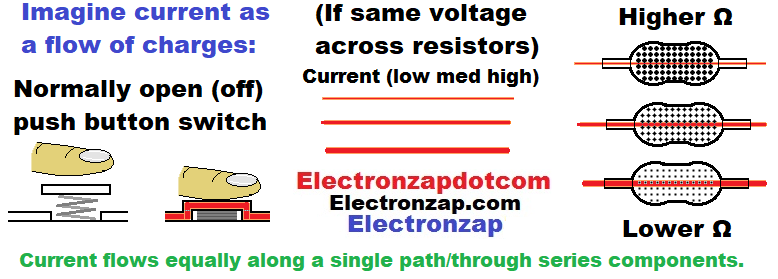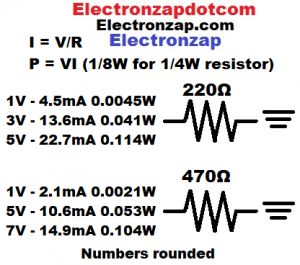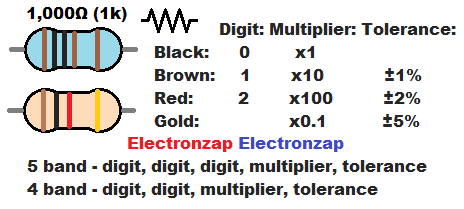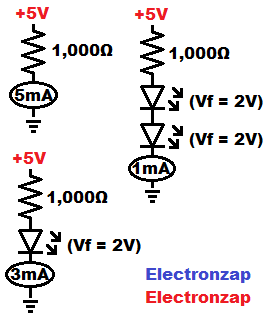Table of Contents
The current (I) through a resistor is determined by the voltage (V) across it, divided by its resistance (R). Giving us the Ohms law formula for current: I = V/R.

- Unit for current = Amp.
- Symbol for current = A
- One amp is one coulomb of charges moving past a given point of a circuit each second. There are approx. 6.24 x 1018, or 6,240,000,000,000,000,000 charges in a coulomb. Two amps is two coulombs of charges most past any given point of a series circuit per second. And so on.
- Conventional Current:
- Early scientists guessed that the moving charges were positive, and flowed from more positive to more negative. It is still usually imagined that way while studying or designing circuits and schematics.
- Electron flow:
- In reality, the moving charges are electrons which flow from negative to positive voltage. Better understanding of what is happening at an atomic level requires the understanding of electrons and how they move.
1 volt across a resistor:
Below are calculations of current through common resistances when 1V is across them . Most resistors are rated for 1/4W maximum, which is recommended to still stay below 1/8W as much as possible.

- 1V/1Ω = 1A (you’d want it to be a 2W resistor).
- 1V x 1A = 1W (one watt of power that needs to be dissipated). That’s why you want a 2 watt resistor, so that you have a safety margin.
- 1V/10Ω = 0.1A (100mA).
- 1V x 0.1A = 0.1W.
- 1V/100Ω = 0.01A (10mA).
- 1V/1,000Ω = 0.001A (1mA).
- 1V/10,000Ω = 0.0001A (100µA).
That is how much current you can expect for each volt across those resistances.
- 10 times as much voltage across a given resistance will result in 10 times as much current. There is a linear relationship.
Keep in mind that 10 times the voltage and 10 times the current means that there is 100 times the power (heat generated) by a resistance. You need to be a lot more careful as voltages and currents rise.
5V across a resistor:
Five volts is a commonly used voltage in electronics. So, below are some common current examples at 5V. Notice that with 5 times as much voltage across a particular resistance amount, there is also 5 times as much current flowing through it. The voltage and current relationship with resistance is linear. Since the wattage (heat generated) is voltage times current, that means a given resistance creates 25 times as much heat generated with 5V across it, compared to 1V.
With resistance: 5 times the voltage across it, equals 5 times the current through it, which is 25 times the heat generated.
- 5V/1Ω = 5A (you’d want to use a 50W resistor).
- 5V x 5A = 25W.
- 5V/10Ω = 0.5A (500mA). You’d want to use a 5W resistor.
- 5V x 0.5A = 2.5W.
- 5V/100Ω = 0.05A (50mA). You’d want to use a 0.5W resistor.
- 5V x 0.05A = 0.25W.
- 5V/1,000Ω = 0.005A (5mA).
- 5V x 0.005A = 0.025W.
- 5V/10,000Ω = 0.0005A (500µA).

Most resistors have black and or brown color bands on them. So I made this simplified color diagram to quickly introduce what those bands mean in the color code.
Most components have a wattage rating that you need to be aware of.
It is very important to learn how to calculate wattage to prevent damaging components and maybe starting a fire, or other damage.
- P = VI
Power (P) in watts is simply the voltage in volts across a component, times the current in amps through the component.
You want components to be rated for twice the power they are expected to have to dissipate while having access to room temperature air.
Most resistors are rated for 1/4W (0.25 watts). You can usually use 1/4W resistors of the value shown in schematics unless they indicate to use a resistor with a higher wattage rating. But they could have also forgotten to note the wattage needed, so it’s good to double check yourself.
Voltage drop and resistors:
Resistors are commonly used to protect series semiconductors that can’t limit current on their own. The resistors still set the current, but certain semiconductors drop a predictable amount of the supply voltage from the resistor.
- Series components results in less voltage across a resistor.

Red, orange and yellow indicator LEDs typically drop about 2V from series resistor(s). They have a forward voltage of about 2V. That is approximately the voltage at which they start conducting and hold across them while conducting.
Blue, green and white indicator LEDs typically drop about 3 volts from a series resistor. They have a forward voltage of about 3V.
- A lone 1,000Ω resistor with 5V across it will pass about 0.005A (5mA) of current.
- One 2Vf (2 volt forward voltage) LED in series with a 1k resistor being powered by a 5V power supply, will result in approx. 0.003A (3mA) of current through them.
- 5V supply minus 2Vf LED = 3V across the series resistor.
- 3V/1,000Ω = 0.003A of current. Usually referred to as 3mA.
- Two 2Vf LEDs in series with a 1k resistor being powered with 5V, will result in about 0.001A (1mA) of current through the entire circuit.
- Both LEDs drop about 2 volts from the resistor before it sets the current. 4V total is dropped in this case, leaving 1V across the resistor.
- 1V/1,000Ω = 0.001A (1mA).
Voltage division and resistors:
Coming soon!
To support this site, check out the following links:
Affiliate link ad of the portable power supply used in my videos. There are larger ones that are cheaper if portability isn’t important. I primarily got this one because I can easily film it next to my circuits while making my YouTube videos.
- Become a Patron!
- Check out my YouTube videos! https://www.youtube.com/c/Electronzap/videos
- Products I used in my videos or otherwise think look like a good buy. As an Amazon associate, I earn from qualifying purchases. https://www.amazon.com/shop/electronzapdotcom
- Information on this site is not guaranteed to be accurate. Always consult the manufacturer info/datasheet of parts you use. Research the proper safety precautions for everything you do.
- Electronzap is a participant in the Amazon Services LLC Associates Program, an affiliate advertising program designed to provide a means for sites to earn advertising fees by advertising and linking to amazon.com.